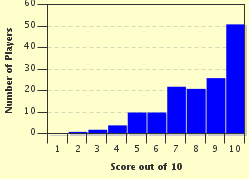Quiz Answer Key and Fun Facts
1. Iron can be found on the Periodic Table of the Elements at atomic number 26. What is its symbol?
2. Iron falls into group 8 on the Periodic Table, along with three other transition metals. They all have similar patterns of electron configurations, resulting in similar chemical behaviour. Which of these other metals is NOT part of Group 8?
3. Speaking of electron configuration... what is the number of electrons per shell for iron?
4. In its natural state (at room temperature), iron is a solid. What, then, is iron's melting point?
5. Iron can combine with many different elements to make chemical compounds, but what is the common name to the iron/oxygen compound iron(III) oxide?
6. One of the most common uses for iron is the production of steel, which is an alloy of iron and (mainly) carbon. But what is the primary added element that makes 'stainless steel'?
7. A material (such as iron, cobalt, or nickel) that can be turned into a permanent magnet is called what?
8. The production and use of iron in history made such an impact on every culture's progression, that it is used to refer to an archaeological era in prehistory. Approximately what span of years was Europe's Iron Age?
9. With so many uses for iron, it is no wonder it is a basis of a high-volume modern industry. Which country (according to the U.S. Geological Survey) produced more than 40% of the world's iron ore in 2015?
10. Iron is also present in our bodies and is essential for healthy red blood cells. What is the term for an iron deficiency in the body?
Source: Author
reedy
This quiz was reviewed by FunTrivia editor
WesleyCrusher before going online.
Any errors found in FunTrivia content are routinely corrected through our feedback system.


